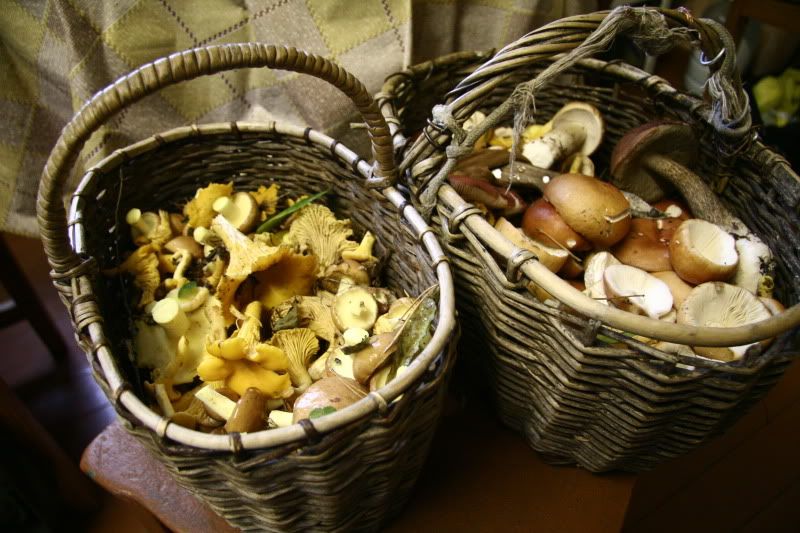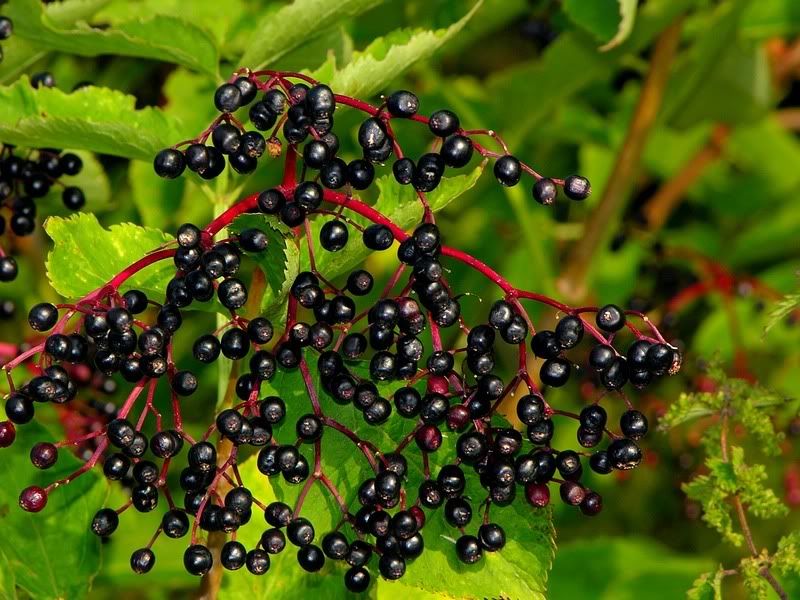
As always, summer seems to be coming to an end far too quickly. Already the turning point of the year is upon us. Though we might welcome the cooling down of summer's heat, and while still being blessed with warm pleasant days, that cool whiff of autumn is unquestionably in the air. With it comes just a twinge of melancholy, after the rupture of vital summer energy, the flowers are setting seeds, the fruits are ripening and the leaves are beginning to turn colors. I love this time of the year. It always seems to me as though the leaves and fruit had soaked up all that sun-power, and now the light and warmth has turned to sweetness and color, painted on all the colorful leaves and stored in the sweet delicious juices of the ripening fruits.
From the foraging point of view it is another season of lavish pickings before the harvesting year is coming pretty much to an end. A couple more months and we'll be at those jars of canned and pickled goodies or forage around in the ice-box for frozen goodies preserved from the summers gifts. But for now there is still more picking to do.

Right now the greatest foraging treasure are mushrooms. And, for those who hunt, the game season has started, too. I prefer the mushrooms. It is difficult to generalize about these incredibly varied creatures though, as they are very ecosystem specific. Also, positive identification is absolutely crucial when it comes to fungi, as many species are inedible or worse, deadly poisonous. If you don't know them well yourself, it is best to get acquainted with them under the guidance of a knowledgeable mushroom connoisseur.

The other mainstays of the season are nuts and seeds. Seeds come in many different shades and sizes and offer a surprising variety of culinary experiences. The seeds of the mustard family herbs for example, such as shepherds purse, garlic mustard, horseradish etc. can be collected and used as a kind of home-grown pepper. They add a nice little twang to any dish without being too overpowering.
Fennel and Dill seeds can be collected and dried for a sweet aromatic flavoring that goes well with fish. The seeds of the umbellifer family tend to be rich in essential oils and often make very tasty spices that can be added to flavored vinegars and oils or pickles.
nuts (12K)Acorns and sweet chestnuts are also getting ready. Acorns are an acquired taste though. Most people find them too bitter. There are techniques for leeching out the bitter component by boiling them with a couple of changes of water. Acorn flour is quite nutritious and can be good when mixed with other flours to add a peculiar nutty flavor to muffins or pancake mixes. There are tons of different species of oak though, and some are definitely more palatable than others. Before loading your bags, you might want to experiment with just a few to see if you like the taste.
As for the sweet chestnuts - don't mistake them with horse chestnuts, which are not edible. Sweet chestnuts have a very prickly coat that protects them quite effectively. Though they look tempting on the forest floor it is best to wait for another month before actually picking them. The first nuts tend to be small and unripe. Their prickly skins don't come off easily and they can be painful to pick. For sweet chestnuts and walnuts I always wait until their outer skins come off by themselves and I just have to pick the nuts. This also avoids black stained hands and finger nails which usually result from picking off green walnut skins.
You might be lucky enough to have edible pine nuts in your area. They are delightful when gathered fresh - and more so when considering their price at the store! However, picking and shelling them makes one realize why they are so expensive. Often birds and squirrels get to the booty quicker and all that is left are the rotten ones - which however is not obvious until one takes the trouble of cracking them, and cracking them IS tedious! (If anybody has come up with a simple method, please let me know)

Elderberries and Blackberries are definitely ripe and ready now and these late berries tend to be sweeter than the early ones. Their high sugar content makes them ideal for making home made wine. Also, if you haven't done so already, stock up with Elderberry cordial - you will be glad you did when the season for colds comes round and this vitamin boost is there to help you through those sniffly times.
Autumn is also the time for harvesting roots. Make sure you only pick those whose supply is plentiful and whose survival will not be threatened by your pickings. Dandelion is a pretty safe pick. It usually grows abundantly and can regenerate even from small pieces of roots left in the ground. Horseradish is also often rather abundant, though digging up the root can be hard work. Other species that might be locally abundant are Parsnip, Inula, Burdock, Evening Primrose and Chichory. Roasted Dandelion roots make a good coffee. The autumn roots tend to be a little sweeter than the spring ones due to their higher inulin content. These can be used in stews and stir fries. The more experimentally minded forager might also try their hand at making Dandelion and Burdock cordial, or brew a beer or wine with them. These types of beverages cannot be compared to what we normally associate with these terms, but they certainly make interesting and unusual nips that, in moderation, can even be regarded as healthy tonics.

I saw all of those elderberries and now I am salivating...wanting to make some good old preserves, lol. I just told my Sister we should be out foraging for them and bringing them home!
ReplyDeleteGreat Post as always Sister Love! And I love seeing your bright and beautiful face first thing in the morning! Oh how I miss you!
Much Love and Many Blessings!